The Battle of the P67 Boards - ASUS vs. Gigabyte at $190
by Ian Cutress on January 20, 2011 4:15 PM EST- Posted in
- Motherboards
- Gigabyte
- Asus
- P67
USB Speed
For this benchmark, we run CrystalDiskMark to determine the ideal sequential read and write speeds for the USB port using our 64GB Patriot SuperSpeed USB 3.0 drive. Then we transfer a set size of files from the SSD to the USB drive, and monitor the time taken to transfer. The files transferred are a 1.52 GB set of 2867 files across 320 folders – 95% of these files are small typical website files, and the rest (90% of the size) are the videos used in the Sorenson Squeeze test.
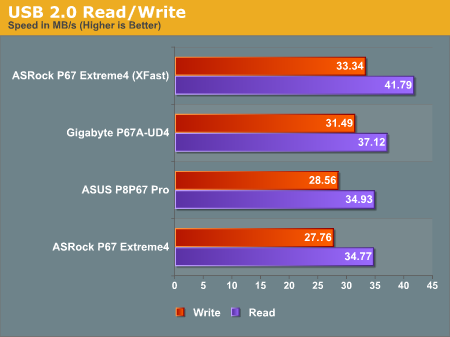
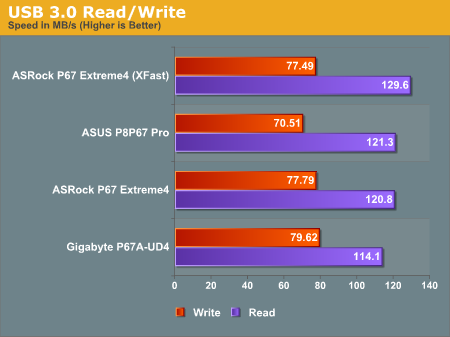
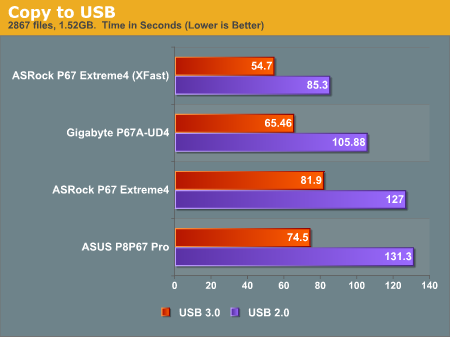
The Gigabyte board overall has the better USB performance, especially in USB 3.0 read speeds. This is accurately translated by the difference in copy time difference between the ASUS and Gigabyte boards in both USB 2.0 and USB 3.0.
3D Movement Algorithm Test
The first benchmark ran is actually one I have written. My full time job involves computational chemistry, so this first benchmark uses various algorithms for three-dimensional simulation and movement of independent particles. The algorithms both employ uniform random number generation or normal distribution random number generation, and vary in various amounts of trigonometric operations, conditional statements, generation and rejection, fused operations, etc. The benchmark runs through six algorithms for a specified number of particles and steps, and calculates the speed of each algorithm, then sums them all for a final score. This is an example of a real world situation that a computational scientist may find themselves in, rather than a pure synthetic benchmark. The benchmark is also parallel between particles simulated, and we test the single thread performance as well as the multi-threaded performance.

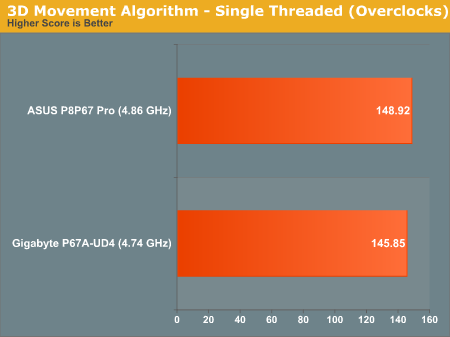
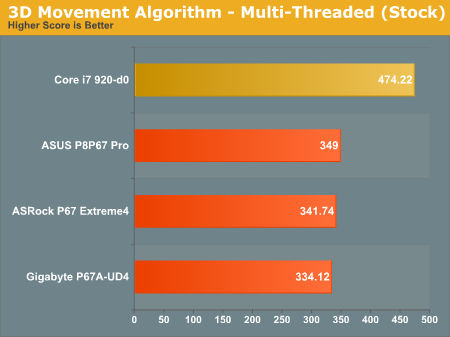
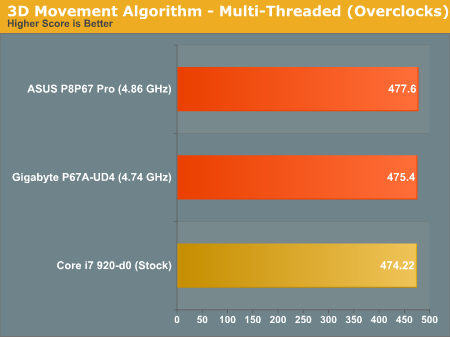
There's barely anything between the boards. The Core i7-920 pulls ahead at stock as it has 8 threads to tackle the workload, whereas the i5-2500K used in the P67 motherboards only has four.
WinRAR x64 3.93
With 64-bit WinRAR, we compress the set of files used in the USB speed tests. WinRAR x64 3.93 attempts to use multithreading when possible.
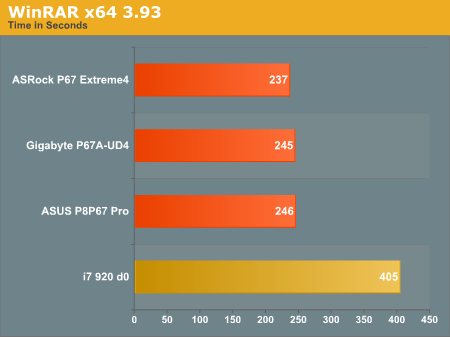
FastStone Image Viewer 4.2
FastStone Image Viewer is a free piece of software I have been using for quite a few years now. It allows quick viewing of flat images, as well as resizing, changing color depth, adding simple text or simple filters. It also has a bulk image conversion tool, which we use here. The software currently operates only in single-thread mode, which should change in later versions of the software. For this test, we convert a series of 170 files, of various resolutions, dimensions and types (of a total size of 163MB), all to the .gif format of 640x480 dimensions.
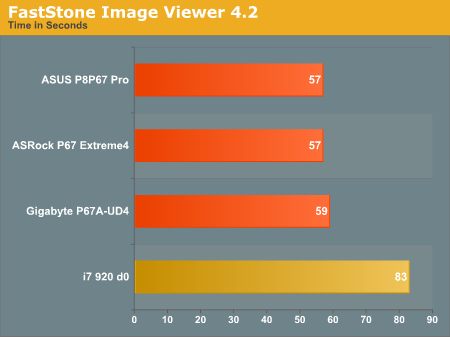
Sorenson Squeeze 6.0
Sorenson Squeeze is a professional video encoder, complete with a vast array of options. For this test, we convert 32 HD videos, each a minute long and approximately 42 MB in size, to WMV 512KBps format. Squeeze can encode multiple videos at once, one for each thread.
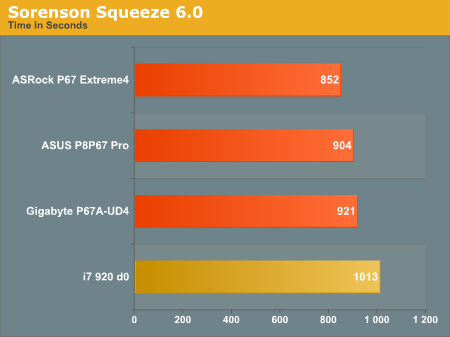
Conclusions
There is not much in it, but the ASUS board performs better in most benchmarks with one exception - the USB speed (especially the USB 3.0 read) is a step behind the Gigabyte.










137 Comments
View All Comments
Tommieemict - Wednesday, June 10, 2020 - link
nude teen sisters on periods https://teenwebcams00.uno">teenwebcams00.uno chubby indian teen nude.CarsonJoine - Wednesday, June 10, 2020 - link
naked mature selfie tits https://maturewebcams00.space">mature wife fuck tube mature fucked at massage.milf sucking teen cock https://milfwebcams00.casa">milfwebcams00.casa homies fuck white milf dp.
amateur big tit teen casting https://amateurwebcams00.xyz">amateurwebcams00.xyz amateur good looking black couple fuck.
2018 black ameature porn in hd https://blackwebcams00.icu">blackwebcams00 black amateur guy fucking amateur mexican girl.
sexy mature latina porn https://maturewebcams00.space">maturewebcams00.space thick huge tit mature pics.
JamesSag - Thursday, June 11, 2020 - link
lesbian initiation rite video https://lesbianwebcams01.fun">lesbianwebcams01.fun vintage lesbian porn gifs.moms gone black porn https://blackwebcams00.icu">pimp wife black men porn lets fuck black pussy couple porn.
gay black porn inetrracil threesomes https://blackwebcams00.icu">blackwebcams00 black nude model art.
dick an jane mature couple tumblr https://maturewebcams00.space">maturewebcams00.space gay mature tumblr masturbation.
two teens caught in pool fuck https://teenwebcams00.uno">petite teen creampie porn curvy teen girl nude strip.
Michaelsok - Friday, June 12, 2020 - link
video asian milf seduces me sex https://asianwebcams00.host">indian boss kissing and sex with receptionist fuck unconscious japanese business woman video.BrianSat - Friday, June 12, 2020 - link
sexy lesbian mom footrub https://lesbianwebcams00.fun">lesbianwebcams00.fun lesbian bondage training porn.hd milf ffm porn https://milfwebcams00.casa">hot thick milf pinterest perfect boobs milf fuck.
fucking a drunk milf https://milfwebcams00.club">milf boss fucks male employee milf monster cock creampie.
Mature blonde gang-raped on a couch https://maturewebcams00.club">maturewebcams00 young old russian mature sex.
white ass black dick https://blackwebcams00.pw">blackwebcams00.pw sexy ebony lesbian threesome.
Steveunfah - Sunday, June 14, 2020 - link
indian wife nude orgy outdoor https://asianwebcams00.host">massive asian tits tumblr asian teen fucks boyfriends friend.mary jane scott college girls nude https://collegewebcams00.store">naked college girl sex college girl rides cock gif.
chubby anal bbc amateur https://amateurwebcams00.monster">amateurwebcams00 amateur milf riding big cock creampie.
milf big ass anal https://milfwebcams00.casa">milf wants young cock gif milf next door naked.
asian fucking for a long time https://asianwebcams00.host">hot naked japanese women thai lan hd sex.
JamesSmant - Monday, June 15, 2020 - link
big hairy college cock https://collegewebcams00.store">collegewebcams00.store college girl masturbation color hidden.